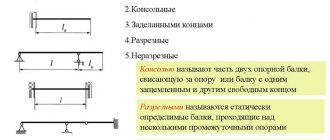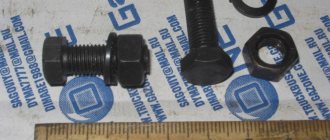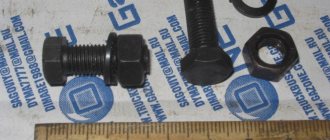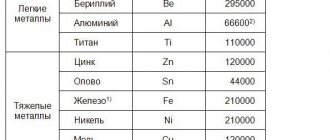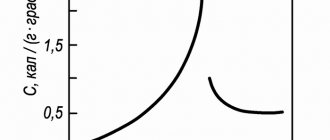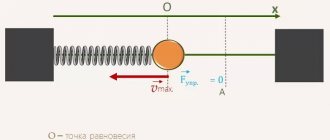Concepts and definitions
The triangle sign was introduced into use by the ancient Greek philosopher and scientist Heron in the first century. Its properties were studied by Plato and Euclid. In their opinion, the entire rectilinear surface consists of many different triangles. In geometry, they mean an area lying in a plane bounded by three segments connecting at three points that do not belong to the same straight line.
The lines forming the area are called sides, and the points of contact of the segments are called vertices. The main elements of a polygon are:
- Median is a line segment connecting the middle with the opposite angle. A triangle has three medians that intersect at one point. It is called a centroid and determines the center of gravity of an object.
- Height is a line descended from the vertex to the opposite side, forming a right angle with it. The intersection of the heights is called the orthocenter.
- A bisector is a straight line drawn from an angle in such a way that it divides it into two equal parts. If you inscribe a circle in a triangle that touches its sides, then its center will coincide with the point of intersection of the bisectors. This place is called incenter.
Depending on the types of angles, triangles are divided into acute, obtuse and rectangular. But whatever the type of figure, there is a pattern that the sum of all angles is always equal to 180 degrees. Therefore, at least two corners must be acute.
Triangles are also distinguished by the number of equal sides. So, if they are all equal, the figure is called equilateral. When only two sides coincide in size, then the polygon is isosceles. Its main property is that the angles are equal. A special case of an isosceles polygon is a regular triangle (scalene).
To avoid confusion, there are standard designations for quantities. The vertices are signed with capital letters A, B, C, and the corners with Greek symbols: α, β, γ. The sides are designated by capital letters of the Latin alphabet: a, b, c.
Properties of a right triangle
A right triangle is a symmetrical polygon whose two angles add up to 90 degrees. Since the total sum of all three angles is 180 degrees, then the third angle is correspondingly equal to 90 degrees. The sides forming it are called legs, and the remaining segment is called the hypotenuse.
The main properties of the figure include the following:
- the hypotenuse of a polygon is always greater than any of its legs;
- the side opposite the 30 degree angle is half the hypotenuse;
- two legs are the altitudes of the triangle;
- the middle of the circle described around the figure coincides with the hypotenuse, while the median dropped from the right angle to the hypotenuse is the same as the radius of the circle;
- the numerical value of the hypotenuse squared is equal to the sum of the squares of the legs (Pythagorean theorem).
When solving geometric problems, these basic features help determine the class of a triangle and calculate its dimensions. Of great importance in this case is the calculation of the values of the legs.
So, if the hypotenuse is known, then finding the legs, knowing the angle, will not be difficult. Having determined the length of the legs, you can calculate the remaining side using the Pythagorean theorem. The perimeter of the figure is determined by adding the two legs and the hypotenuse, and the area is found by multiplying the legs and dividing the resulting answer by two.
Knowing the legs, it is quite easy to calculate the angle. You just need to remember that the ratio of the sides to each other is equal to the tangent of the opposite angle and the cotangent located nearby. Moreover, knowing any of the angles, you can find the second one by simply subtracting the known value from ninety. The height of a rectangle is equal to the cosine of the adjacent angle.
The formula for finding the bisector and median is quite complicated. To find the first quantity, the transformation of the radical from the sum of the squares of the legs to two is used, and the second is the substitution of the radical instead of the side lying opposite the right angle.
Control methods
Welding seam control is an integral part of the technological process. First of all, the connection must be examined for resistance to destructive loads. Forms of control can be different. They depend on the principles on which they are based. Advanced techniques include radiography, x-ray, gamma ray, ultrasonic and eddy current testing. Magnetic probing should also be added here, as well as the capillary method of examining seams. The presented types of control require expensive equipment and cannot always be implemented, especially in small-scale production conditions.
A ready-made template can serve as a handy device for measuring legs. To be precise, it is not just one template that is of practical importance, but a whole set.
In its simplest design, the template is a set of plates held together at one end. At the other end there are slots corresponding to the shape of the cross section of the seam. The master one by one applies the templates to the workpiece and determines the most appropriate one. Each template is marked with the size of the corresponding leg.
There are several other devices that, by their operating principle, represent templates, only the way they measure legs is slightly different. The Krasovsky template is designed to determine the gaps between workpieces. Universal welder's template (UNS-2) - a set of plates with cutouts. The length of the legs can be determined by the shape of the convex hypotenuse. The Marshak-Usherov template allows you to measure not only the leg, but also determine the root of the seam. This device is considered the most versatile of all those described above.
Pythagorean theorem and angles
This theorem occupies one of the central places in mathematics. Its algebraic formulation states that in a rectangle, the square of the length of the hypotenuse is equal in value to the sum of the squares of the two sides adjacent to it, that is, the legs. For example, if we denote the hypotenuse by the letter c, and the legs a and b, then mathematically it can be written as a formula: a2+b2 = c2.
There are several proofs of this theorem. The simplest of them is to use the similarity of triangles. It is based on axioms. Let there be a geometric figure ABC whose vertex C is straight, that is, its angle is 90 degrees. If we lower the height from point C and mark the intersection with the opposite side as H, we get two triangles. One will consist of AHC vertices and the other BHC. These new figures are similar to ABC at two angles. The following expressions will be correct:
- BC/AB = HB/BC;
- AC/AB = AH/AC.
The given entries are equivalent to the equalities: BC2 = AB * HB; AC2 = AB * AH. By adding the first and second formulas, we get: BC2 + AC2 = AB * (HB + AH) = AB2. Which is what should have been proven.
Using this fundamental rule and the property that a leg located opposite an angle of 30 degrees is equal to half the hypotenuse, many calculations are carried out related to calculating the lengths of the sides. To prove that AC = BC/2, the following reasoning is given.
Since the top of B is 30 degrees, then, according to the rule, the turn C should be C = 30 * 2 = 60 degrees. You can attach exactly the same figure to the existing triangle, making side AB the center of symmetry. Then for the polygon BCD it will be true that B = D = 60º. Based on this, we can say that DC = BC. But, since AC = ½ DC, then AC = ½ BC.
But all the data necessary to find the length of the leg using the above theorems is not always known. Therefore, trigonometric ratios are also used to calculate the legs.
Calculation
In a strict sense, to determine the size of the weld leg, it is necessary to take into account a number of factors. The most significant of them is the thickness of the workpiece. Even a novice craftsman knows that the geometry of the weld directly depends on the required penetration depth. This relationship becomes somewhat more complicated if you have to connect two parts of different thicknesses.
Additional factors include such as the position of the electrode, the type of connection, and the physical properties of the metal. A complete calculation of a welded joint involves the use of a number of complex formulas. In practice, if the metal structure will not be subject to ultra-high loads, simplified calculation principles are used.
For example, when connecting two parts of the same thickness, the leg is considered equal to the edge of the part. If the thickness of the material is different, then they are guided by the parameters of the thinner workpiece. Let us remind you once again that errors in calculations lead to undesirable consequences. An excessively small leg degrades the strength of the weld, while a large leg can cause internal stress in the metal.
The above calculation method is valid for average material thicknesses. An increase in thickness leads to a violation of the linear relationship between these parameters. Sufficiently thick parts are welded with a seam to a leg, the size of which is 40% of the thickness. As can be seen from the example, it is problematic to observe such a complex relationship; however, the leg size is a value defined by the GOST 5264-80 standard.
In some cases, the approximate value of the leg gives too large an error, so it is customary to use a simplified formula. They look like this:
T=Scos45°, where T is the size of the leg, and S is the width of the seam. Since we illustrated the geometric parameters, in our notation this formula will look like: K=ecos45°. Considering that the cosine of the angle is a constant value, we come to the conclusion that in this case the leg is linearly “tied” to such a parameter as the width of the weld (but not the thickness of the edge).
Trigonometric formulas
To find the length of a leg of a right triangle, simple formulas are used. To use them, you need to know the value of any of the sides and the amount of rotation of an arbitrary vertex. There are four ways to find a leg using trigonometric rules:
- It is based on the axiom that the sine is found from the ratio of the opposite side to the hypotenuse. For example, let it be known that the length of the hypotenuse is 100 centimeters, and vertex A has a turn of 30 degrees. Using trigonometric tables, we can state that the sine of angle A is ½. Taking into account the transformed expression, the leg is found: a = 100 / 2 =50 (cm). Thus, the sine of an acute angle is numerically equal to the ratio of one of the legs divided by the hypotenuse: sin A = BC/AB.
- The rule used is that the cosine in a rectangle is the ratio of the adjacent leg to the right angle and the hypotenuse: cosA = AC/AB. For example, let the rotation of vertex C be 60 degrees and the hypotenuse be 100 centimeters. According to the trigonometric table, an angle of 60 degrees is equal to ½. By substituting this value into the formula, you can find the value of the leg: a=cos∠C*a; b=½*100=50 centimeters.
- The tangent of an angle can be calculated by dividing the length of the opposite leg by the adjacent one. The mathematical formula for this statement is: tg = BC/AC. The leg of a polygon can be found as b = tg * a. For example, it is known that one of the angles of the figure is 45 degrees, and the length of the hypotenuse is 100 centimeters. Since the tangent of 45 degrees is equal to one, the answer to the problem will be: a = 1*100 = 100 centimeters.
- The cotangent is determined from the ratio of the adjacent side to the opposite side. In fact, this is the reciprocal of the tangent: ctg = AC/BC. For example, let the rotation of angle A be 30 degrees, and the length of the leg opposite it is 50 centimeters. The cotangent of 30 degrees corresponds to the root of three. By substituting known data into the formula, you can calculate the unknown leg: b = 50√3 centimeters.
Knowing what trigonometric formulas look like and the content of the two theorems, it will be possible to calculate the value of the leg in most of the tasks.
Typical examples
To solve problems on finding a leg, you do not need to have any special knowledge. You just need to carefully analyze the condition . For example, let it be known that in a rectangle one leg is five centimeters longer than the other. In this case, the area of the figure is 84 centimeters square. It is necessary to determine the lengths of the sides and the perimeter.
Since the area is given in the condition, when solving it is necessary to start from it. It is known that the area of a right triangle is found by the formula: S = AC*CB/2. This expression is a special case of the general formula for finding the area of any triangle, where: AC is the height and CB is the base. If we assume that AC is equal to X, then, according to the condition, the length of CB will be x+5.
Based on this, the area of the triangle will be equal to: S = (x*(x+5))/2. By substituting a given value for S, you can get a quadratic equation: x2 + 5x - 84 = 0. It is better to solve it using the determinant method. The roots of the equation will be -12 and 7. Since -12 does not satisfy the conditions of the problem, the correct answer will be seven.
The length of the second leg is seven centimeters. First: AC = 7−5 = 2 cm. Knowing both sides, using the Pythagorean theorem you can find the hypotenuse: c = (22 + 72)½ = (4+49)½ = 531/2 = 7.3 cm. Having found the lengths of all sides, you can easily find the perimeter using ordinary addition: P = 2+7+7.3 = 16.3 cm. The problem is solved.
Quite interesting, but at the same time simple problems of finding the sides and angles for a known length of the hypotenuse and the rotation value of one of the vertices. Let there be a right triangle whose hypotenuse BC is equal to five centimeters, and the angle between it and the leg is 60 degrees. All other sides and angles need to be determined.
Since the hypotenuse and the acute angle are known, using trigonometric formulas, you can find the lengths of the legs: AC=BC*sin60 = 5*(3)½/2; AB=BC*cos60 = 5/2. The sum of all angles in a triangle is equal to 180 degrees, since one of them is right, and the second is given and is 60 degrees, then the third is found by subtracting C = 180 - (90 + 60) = 30.
Examples of problem solving
Task #1:
In triangle ABC with ∠A=90 degrees, ∠C=60 degrees and side AB=5 cm. Find the length of side AC.
Solution:
In right triangle ABC we find angle B:
∠B=90o - ∠C=90o - 60o = 30o
Since ∠B = 30 o, then leg AB is equal to half the hypotenuse BC, which means
BC=2AB=10 cm
We find the length of the side AC using the Pythagorean theorem:
Task #2:
In an isosceles and right triangle ABC, the hypotenuse is 2 cm greater than the leg. Find the length of the sides of the triangle.
Solution:
In the triangular figure ABC we denote the legs AB=AC=x, then BC=2+x. Let us write down the Pythagorean theorem for this triangle:
BC2= AB2 + AC2 => (x+2)2 = x2 + x2 or x2 – 4x – 4 = 0
Solving this equation and taking into account the conditions of the problem, we obtain
x= (2+2) cm
those. AB = AC = (2+2) cm, BC = (4+2) cm
Answer: AB = AC = (2+2) cm, BC = (4+2) cm
As you can see, the process of solving geometric problems of finding a leg in a right triangle is not particularly difficult. You just need to make an effort, sit and understand the essence of the task. When you start writing formulas, the solution will come to you on its own. Good luck solving geometry problems, now you know how to find the leg of a right triangle.
